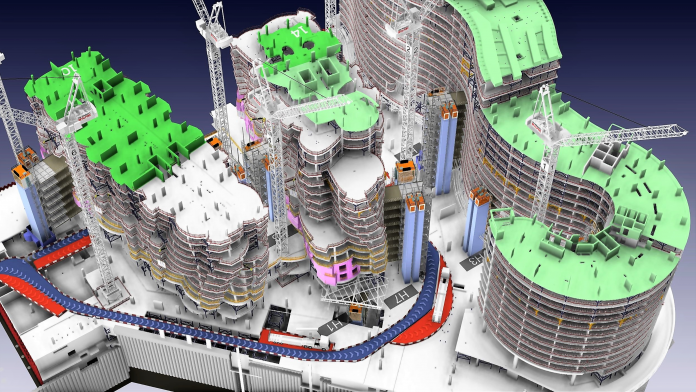4D BIM is the process of using 3D models combined with time and schedule-related information such as programmes, site surveys and logistics models to create a virtual construction sequence
To put it simply, 3D models + time information = 4D.
A 4D model is a simulation of construction activities. Most modern forms of 4D model use specific 4D software and in this software, information related to time, site, design and logistics is combined.
These combined 4D models are then used by project teams to help visually plan, design and construct built assets. Ultimately, 4D enables project teams to coordinate resources, improve communication and make informed decisions during the project lifecycle.
Although the term has been widely used and recognised within the industry for over a decade, it is often mistaken as a buzzword or “too techy” a concept, which has led to much confusion and countless missed opportunities. It is therefore important that we adopt a consistent approach to 4D BIM and share best practices to unlock its true value and potential.
While some project design teams are successfully using 4D planning to optimise project delivery in operational assets (such as airports and rail stations), it’s safe to say that – at present – 4D is most commonly used by contractors to win projects. Though, this is often for their own benefit and generally ad hoc depending on the projects.
So, what is the missing link and how can we encourage a consistent, likeminded approach to 4D BIM adoption?
One simple, yet effective, way to optimise the benefits of 4D BIM is for clients and appointing bodies to set out a clear, structured and purpose-driven 4D strategy at the outset of the project. Not only would this small shift in behaviour help drive significant change within the industry, but also it would help set the “tone from the top” and help encourage and reassure project teams that the client is sure about what they want. In turn, this meaningful approach will help instil confidence in stakeholders that their project teams and suppliers are on board with their digital construction vision and are putting efficiency, planning and resourcing at the forefront of the project to help manage and avoid delays.
That said, without any industry standards or industry bodies leading the way, construction planning is a dispersed community which is usually in disagreement about standard methods and terms of reference. This type of disjointed approach ultimately leads to ambiguity in documents, missed opportunities and fundamentally, a stark difference between expectation vs reality.
The lack of consistency around the adoption of 4D BIM typically results in abortive work and countless missed opportunities. However, the answer is obvious: consistency is key. As an industry, we are inherently coy about sharing our experiences and lessons learned. Once the knowledge base increases and the industry becomes savvier, we will naturally derive a consistent understanding of what is meant by “4D”. It is our view that standardisation and consistency across the board is absolutely essential to maximise the full potential of 4D, and as explained below, we are confident that the introduction of the 4D Exchange Information Requirements (EIR) document will help facilitate this much-needed change.

What is required to adopt 4D BIM on your project?
Standards, process, definitions
A form of shopping list that can be selected by clients, contractors, suppliers and designers to specify what outcomes they want get from adopting 4D. A template that defines the purpose, content, authors, contributors and level of detail and use cases to set expectations and alignment. Something that sets out when the 4D model is going to be used, by whom and at what expected level of detail is. (For the model, information, and programme/schedule):
Examples of use cases include:
- Early planning/design stages.
- Procurement support.
- Pre-construction verification.
- Supply chain coordination and interface management.
- Health and safety, planning, communication, site inductions.
- Tracking and reporting progress.
- Managing works and change.
- Capturing and sharing lessons learned.
- Demolition, maintenance and occupancy.
- Claims support and forensic analysis.
- All of the above…
The 4DCG EIR Template
Overview of the 4DCG EIR
The 4D Construction Group (4DCG) is an independent industry body. The 4DCG developed a free 4D Exchange Information Requirements (EIR) to help organisations adopt 4D quickly and easily.
The document can be used by appointing parties or appointed parties, these can be owners, contractors, consultants or subcontractors. Project teams are encouraged to modify the document to meet their specific needs and to share any updates and suggestions with the 4DCG (info@4d.construction).
The EIR document starts by specifying the purpose of using 4D planning. Once the purpose is defined, the documents specified what inputs and outputs each party is required to supply.
Examples of inputs and outputs are included in the template based on the experience of members in the 4DCG. It is also important to state which party is delivering the input or output, in what format it is required and how frequently it will be updated. Examples of items covered in the template include:
- Provision of 3D models.
- Provision of other information required to develop the 4D model.
- Provision of schedules.
- Provision of software.
- Resources to develop and review the outputs.
- The benefits and purpose of adopting 4D.
- The expected outcomes.
- The types of outputs expected.
- The 4D BIM Execution Plan.
- The 4D model requirements.
- The use of 4D through the different project phases/stages.
- The process of developing 4D.
- How 4D workshops will be used.
- Technical software and hardware requirements.
The benefits of adopting a 4D EIR are simple. Project teams will reduce wasted effort by focusing on the important tasks. The 4D EIR also helps teams start 4D on their project quickly and save money by using 4DCG standard as a starting point.
The authors would like to thank Pieter Rautenbach, digital and risk director at Newstead Connect, and Chris Needham, director of CSN Project Planning, for their editing support.
James Bowles
Director
Freeform
james@freeform3d.co.uk
www.freeform4d.co.uk
Twitter: @James4D
LinkedIn: Freeform
Harlene Gill
Commercial associate and solicitor
Buro Happold
Tel: +44 (0)1225 320 600
www.burohappold.com
Twitter: @burohappold
LinkedIn: Harlene Gill
Youtube: Buro Happold















Nicely explained the core functions of 4D modeling. The benefits of scheduling and sequencing are limitless.